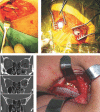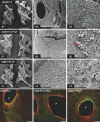Translating tissue engineering technology platforms into cancer research
- PMID: 19627398
- PMCID: PMC3828855
- DOI: 10.1111/j.1582-4934.2009.00853.x
Translating tissue engineering technology platforms into cancer research
Abstract
Technology platforms originally developed for tissue engineering applications produce valuable models that mimic three-dimensional (3D) tissue organization and function to enhance the understanding of cell/tissue function under normal and pathological situations. These models show that when replicating physiological and pathological conditions as closely as possible investigators are allowed to probe the basic mechanisms of morphogenesis, differentiation and cancer. Significant efforts investigating angiogenetic processes and factors in tumorigenesis are currently undertaken to establish ways of targeting angiogenesis in tumours. Anti-angiogenic agents have been accepted for clinical application as attractive targeted therapeutics for the treatment of cancer. Combining the areas of tumour angiogenesis, combination therapies and drug delivery systems is therefore closely related to the understanding of the basic principles that are applied in tissue engineering models. Studies with 3D model systems have repeatedly identified complex interacting roles of matrix stiffness and composition, integrins, growth factor receptors and signalling in development and cancer. These insights suggest that plasticity, regulation and suppression of these processes can provide strategies and therapeutic targets for future cancer therapies. The historical perspective of the fields of tissue engineering and controlled release of therapeutics, including inhibitors of angiogenesis in tumours is becoming clearly evident as a major future advance in merging these fields. New delivery systems are expected to greatly enhance the ability to deliver drugs locally and in therapeutic concentrations to relevant sites in living organisms. Investigating the phenomena of angiogenesis and anti-angiogenesis in 3D in vivo models such as the Arterio-Venous (AV) loop mode in a separated and isolated chamber within a living organism adds another significant horizon to this perspective and opens new modalities for translational research in this field.
Figures




References
-
- Langer R, Vacanti JP. Tissue engineering. Science. 1993;260:920–6. - PubMed
-
- Wu X, Rabkin-Aikawa E, Guleserian KJ, et al. Tissue-engineered microvessels on three-dimensional biodegradable scaffolds using human endothelial progenitor cells. Am J Physiol Heart Circ Physiol. 2004;287:H480–7. - PubMed
-
- Feder-Mengus C, Ghosh S, Reschner A, Martin I, et al. New dimensions in tumor immunology: what does 3D culture reveal? Trends Mol Med. 2008;14:333–40. - PubMed
-
- Paszek MJ, Zahir N, Johnson KR, et al. Tensional homeostasis and the malignant phenotype. Cancer Cell. 2005;8:241–54. - PubMed
Publication types
MeSH terms
LinkOut - more resources
Full Text Sources

